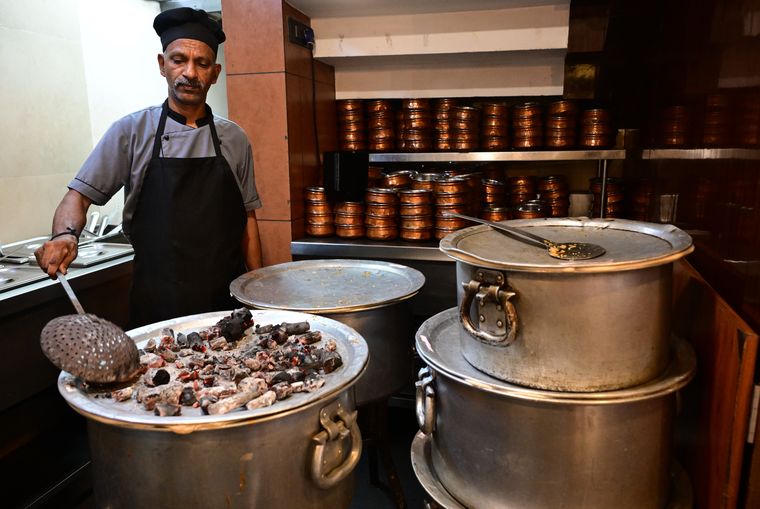In the late 1930s, a young man from the princely state of Travancore, Meeran Pillai Pareed Kunju, embarked on a journey to Surat, Gujarat. Driven by an aching desire to reunite with his mother who was staying with his sister, Kunju spent months wandering the unfamiliar city in search of her. But fate had other plans. His sister's family had already left Surat, migrating to a land that, within a decade, would become part of the newly formed Pakistan.
Before setting out on this quest, Kunju had run a modest tea shop at Vallakadavu in Thiruvananthapuram, which he had to shut down to pursue his search. His return to Travancore was far from fruitless. During his time away, he mastered an intricate and unique style of dum biryani preparation, blending the rich culinary traditions of the Muslim community in Travancore with the flavours and techniques prevalent in Surat.
At the time, biryani was a dish of exclusivity in Travancore―reserved for grand functions and accessible only to the elite. Kunju sought to change that. In 1940, he opened a new eatery at Vallakadavu, introducing his perfected recipe to the public.

Kunju was deeply inspired by the freedom fighter Maulana Abul Kalam Azad. His profound admiration and nationalist fervour earned him the nickname "Azad", a moniker he wholeheartedly embraced. Thus, M.P. Azad was born, and his name soon adorned the signboard of his eatery. His signature creation, the Azad Travancore Pakka Biryani, with its intricate and almost meditative cooking process, carved its own niche in the cultural and culinary history of Kerala.
Fast forward to 2025―biryani has become a ubiquitous dish, available in every corner of Kerala. Yet, the Azads, now running not just eateries but a diverse portfolio in the food and hospitality industry, assert that replicating the Azad Travancore Pakka Biryani is nearly impossible. Abdul Nazar Azad, son of M.P. Azad and chairman of Azad Corporate, who has helmed the family business since the late 1970s, says their 85-year-old biryani tradition is labour-intensive, time-consuming and expensive. But he adds that it continues not just as a tribute to his father’s legacy but also as a commitment to preserving the authentic taste that has been carefully passed down through generations.
“Most restaurants and hotel chains in Kerala have shifted to using the short-grained and relatively cheaper kaima rice for preparing biryani,” explains Ozman Azad, the grandson of M.P. Azad, who currently co-manages the group with his brothers Mahin and Wazim Azad. “However, we remain true to our roots by using long-grained basmati rice and adhering to a meticulous cooking tradition. This involves layering ingredients and rice step by step, a method perfected by my grandfather.”
The masala is first prepared in batches of 100kg. Country mutton from Thiruvananthapuram and Kollam districts, which is renowned for its quality, is used. These goats, who are fed jackfruit leaves that make their meat tender and flavourful, are unique. The biryani is made in batches of 50, to ensure it remains hot and fresh for the customers. “The process includes preparing the rice in three stages of cooking," says Mahin. "Each layer of partially-cooked rice is placed over the masala. After adding ghee, the vessel is sealed for dum cooking. The biryani is cooked for 30 minutes, during which the flavours rise through the layers of rice. Afterwards, the vessels are sent to the shops and the dum remains sealed for another 30 minutes before it is served.” Mahin adds that when the biryani is served, each layer contributes a unique flavour, making every serving a blend of all three layers. "This meticulous process requires immense skill and cannot be easily replicated. While Kerala biriyani varieties like Thalassery biryani can be recreated, the complexity and precision of this traditional dum biryani make it one of a kind," he says.
Notably, the history of the Azads is as richly layered as the Azad Travancore Pakka Biryani itself, and steeped in Kerala's cultural and political history. In the 1950s, when famine struck the erstwhile Travancore region, a ban was imposed on transporting rice grains from Nagercoil to Thiruvananthapuram. M.P. Azad ingeniously bypassed this rule by transporting cooked rice from Nagercoil to alleviate the scarcity.
The 1960s marked a period of expansion for Azad Hotels, with new outlets opening in Thiruvananthapuram, Kollam, Nagercoil and Madras. Soon, Azad biryani became a coveted prize in friendly bets, as the tradition of the loser buying the winner a biryani became ingrained in the culture of the Travancore region. In 1962, a 17-year-old boy, Gopi Pillai, joined the Madras outlet of the hotel launched by M.P. Azad. Gopi remains on the Azad payroll to this day. “Gopi is our employee number one. He has worked with three generations of the Azad family. There is no retirement age at Azad. People can work if their health permits and they wish to continue,” says Wazim. Gopi told THE WEEK that other than during the Covid pandemic, when the elderly were advised to stay home, he has never been away from his work at Azad.
In 1967, Azad Hotels opened a prominent outlet at Statue Junction, opposite the Kerala government secretariat. The restaurant quickly became a buzzing hub where politicians of all affiliations gathered to discuss strategy. Over time, the south gate of the secretariat―a landmark for protesters and journalists―came to be known as the “Azad Gate”.
However, in Kerala’s highly political atmosphere, where trade unionism is strong, Azad Hotels faced a historic workers’ strike. “My father was always particular about giving employees a salary hike, even without political pressure. But trade union leaders would still make demands, and whenever a salary hike was announced, they would take the credit. In 1976, after a hike had already been granted, union leaders insisted on an additional 50 paise increase. When my father refused, AITUC (All India Trade Union Congress) called for a lightning strike at lunchtime―after all the food had already been prepared,” recalls Abdul Nazar. “Many workers were forced to join the strike under pressure from union leaders and refused to serve food. My father then ordered all three outlets in Thiruvananthapuram to shut down. The cooked food was left to rot inside.”
Ironically, when the Azads decided not to reopen the outlets, the same trade union leaders who had led the strike began protesting for the branches to be reopened. “Comrade N. Aravindan even staged a satyagraha in a makeshift venue in front of Azad Gate, demanding the reopening of the restaurants,” says Abdul Nazar. The Chalai and Statue Junction branches finally reopened after months, following intervention from then labour minister Oommen Chandy, who facilitated a compromise.
In the 1980s, under Abdul Nazar’s leadership, the Azad group pioneered a mega change in the prevalent culture in Travancore. Azad, which had catered largely to a male-dominated clientele, evolved into a family-oriented establishment. “In cities like Chennai, families had started dining out in the 1960s, but in our region, restaurants were still male-dominated spaces. Even in high-end establishments and motels, it was rare to see women dining out. My father [Abdul Nazar] pioneered a shift by creating a dedicated space for families, training his team to cater to them, and fostering a family-friendly dining culture,” says Wazim. “Visiting Azad became part of a family outing―people would watch a movie, shop for clothes, visit exhibitions or circuses at Putharikandam Maidan, and enjoy a meal together. This cultural shift marked a turning point. As more families dined out, other restaurants followed suit.”

Before the 1980s, dinner service was almost non-existent in Kerala. Restaurants mostly operated until 4pm, catering primarily to the clerical and working-class crowd. “But with the rise of family dining, dinner service became popular, ushering in a new era. This change also led to menu diversification―premium meals, Chinese cuisine and more seafood options were introduced,” says Ozman.
Today, Kerala pulses with a vibrant restaurant culture boasting thousands of eateries. Yet amid this culinary revolution, Azad stands apart. Eschewing bulk deals with large suppliers, Azad champions a trust-based model, sourcing from the traditional small-scale vendors of the Travancore belt―which acted as a lifeline for these communities, especially during the pandemic.
Azad has a unique method for transferring knowledge from one generation to the next in the art of making Azad Travancore Pakka Biryani. "Making this biryani demands true teamwork. We have specialists for every stage, and the new generation learns directly from the experienced hands,” says Ozman. “For instance, one of our employees has been perfecting the art of masala layering for the past 30 years. Each stage involves experts whose combined skills create the final product. At least four people are needed for a single vessel of biriyani. This is one of the reasons why it is so difficult to replicate.”



